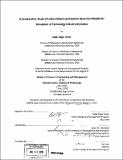A comparative study of Lotka-Volterra and system dynamics models for simulation of technology industry dynamics
Author(s)
Ünver, Hakkı Özgür
DownloadFull printable version (16.06Mb)
Other Contributors
System Design and Management Program.
Advisor
James M. Utterback.
Terms of use
Metadata
Show full item recordAbstract
Scholars have developed a range of qualitative and quantitative models for generalizing the dynamics of technological innovation and identifying patterns of competition between rivals. This thesis compares two predominant approaches in the quantified modeling of technological innovation and competition. Multi-mode framework, based on the Lotka-Volterra equation barrowed from biological ecology, provide a rich setting for assessing the interaction between two or more technologies. A more recent approach uses System Dynamics to model the dynamics of innovative industries. A System Dynamics approach enables the development of very comprehensive models, which can cover multiple dimensions of innovation, and provides very broad insights for innovative and competitive landscape of an industry. As well as comparing these theories in detail, a case study is also performed on both of them. The phenomenal competition between two technologies in the consumer photography market; the recent battle between digital and film camera technology, is used as a test case and simulated by both models. Real market data is used as inputs to the simulations. Outputs are compared and interpreted with the realities of the current market conditions and predictions of industry analysts. Conclusions are derived on the strengths and weaknesses of both approaches. Directions for future research on model extensions incorporating other forms of innovation are given, such as collaborative interaction in SME networks.
Description
Thesis (S.M.)--Massachusetts Institute of Technology, System Design and Management Program, 2008. Includes bibliographical references (leaves 78-80).
Date issued
2008Department
System Design and Management Program.Publisher
Massachusetts Institute of Technology
Keywords
System Design and Management Program.